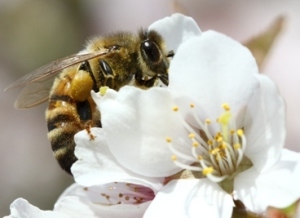Study shows urban habitats provide haven for UK bees
Release Date 11 February 2015

- Bee diversity is higher in urban areas compared to farmland
- Bee abundance in farmland, nature reserves and urban environments did not differ, neither did the number of pollinator species
- Number of rare pollinators did not differ in towns, farms and reserves
- Urban areas are growing and improving their value for pollinators should be part of any national strategy to conserve and restore pollinators
Urban environments might not seem the best habitat for pollinators at first glance but a new study suggests that bees and other pollinating bugs actually thrive as well in towns and cities as they do in farms and nature reserves.
The study, published today in Proceedings of the Royal Society B has for the first time compared the suitability of different landscapes for pollinating insects across the UK.
Bees, which play a vital role in pollinating some of the UK's most important crops, have been declining in recent years, but the effects of urbanisation on pollinating insects is poorly understood.
"Far from being concrete nature-free zones, this study shows British towns and cities are buzzing with insect pollinators." -- Professor Simon Potts
This new research from the Universities of Bristol, Edinburgh, Leeds and Reading in collaboration with the University of Cardiff found that bee abundance did not differ between three studied landscapes (urban, farmland, nature reserves), but bee diversity was higher in urban areas than farmland. They also found that while hoverfly abundance was higher in farmland and nature reserves than urban sites, overall pollinator diversity did not differ significantly.
Professor Simon Potts, University of Reading, who co-authored the study, said: “Far from being concrete nature-free zones, this study shows British towns and cities are buzzing with insect pollinators.
“City bees benefit from the varied landscape of gardens, parks, allotments and scraps of land between buildings and beside roads. Many of these provide ideal nesting, foraging and feeding sites for wild bees and other insects.
“Not only can common species thrive in our cities, but some of our rarest ones find safe havens here too. Five out of eight of the nationally rare bee and hoverfly species recorded in this study were found within Reading.
“We now need to follow a joined-up strategy for both urban and rural areas to boost the numbers and diversity of pollinating species.”
The team compared flower visiting pollinator communities in 36 sites in and around some of the UK's largest towns and cities, recording a total of 7,412 insects visiting flowers. In the study, 11 rare or scarce species were recorded, four of which were also found in urban habitats.
The findings have important implications for pollinator conservation as urban areas in the UK continue to increase in size. The study concluded that ‘urban areas growing and improving their value for pollinators should be part of any national strategy to conserve and restore pollinators'.
The Insect Pollinators Initiative is joint-funded by the Biotechnology and Biological Sciences Research Council (BBSRC), Defra, the Natural Environment Research Council (NERC), the Scottish Government and the Wellcome Trust. It is managed under the auspices of the Living with Environmental Change (LWEC) partnership.
The research was conducted in collaboration with: Avon Wildlife Trust, Berks, Bucks and Oxon Wildlife Trust, Bristol City Council, City of Edinburgh Council, Leeds City Council, National Museum of Wales Cardiff, Reading Borough Council and the Yorkshire Wildlife Trust.
